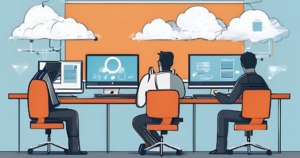How to Manage Projects with Asana
Key Takeaways
- Asana is a powerful project management tool that uses a hierarchy of Workspaces, Projects, Tasks, and Sub Tasks to organize and manage work. It also allows for easy team collaboration with features like task assignments, due dates, and progress tracking.
- The platform integrates with Dropbox, Google Drive, and Box, simplifying asset management. It can also be used to create instant meeting agendas, manage editorial content, maintain a content library, and even manage personal tasks.
- To effectively use Asana, monitor both ‘My Tasks’ and ‘My Inbox’ closely. Avoid overbooking and delegate tasks where possible. The time and frustration saved by using Asana for project management makes the learning curve worth the effort.
“Did you have a chance to look at that email?”
Unsure of where to go next, my pointer hovered over my inbox.
The email my boss was referring to was a collateral piece she wanted my opinion on. I know I’d received it, but who sent it? One of the designers? Did my boss forward it? My mind went blank.
After digging through various inbox folders, I finally laid eyes on the most recent version, and we were able to continue our conversation.
If that sounds familiar, then you know the frustration of using email as a project management and collaboration tool. So stop already.
Author Robert Fritz teaches that every moment you realize you are unhappy or frustrated with a situation is “your point of power”, for now you have a clear Picture of how you don’t want things to be. Imagine the exact opposite of that frustrating situation and there you have the makings of your vision. – The Path
I imagined a tool where conversations existed in one place, instead of scattered across a dozen “reply all” emails. But does such a tool exist?
Of course it does. But the problem wasn’t finding one as much as choosing from the dozens available.
I’d used Asana a few years back and upon revisiting it, I was pleasantly surprised with the improvements they’d made. So here’s an inside look at how our team of two marketers, two designers, a copywriter, a sales director, my boss and myself use it to collaborate on marketing projects.
Setting Up Asana
The first step was deciding on the organizational structure. Asana uses the following hierarchy:
- Workspaces
- Projects
- Tasks
- Sub Tasks
Workspaces
Asana’s free version allows 15 members per Workspace. Each Workspace is a self-contained unit, so Projects and Tasks from one Workspace won’t appear in another.
This is important because if you have too many Workspaces, you’ll have to jump back and forth between each to manage all your projects. So rather than creating multiple Workspaces, I made a single Workspace called “Marketing.”
Projects
Next, I added our current projects. These appear on the left sidebar:
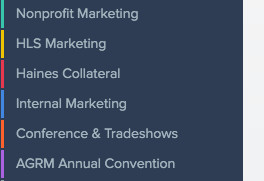
Setting up an inbound campaign requires the same steps every time. So I created a reusable Project named “Template” that included each of those steps as Tasks.
You duplicate the template by choosing “Use as Template (Copy Project)” from the Project menu drop down.
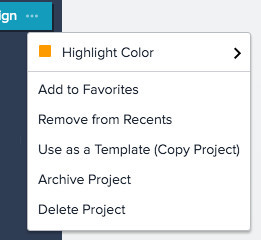
Tasks and Sub Tasks
Within each Project, you have the ability to create Tasks and Sub Tasks. In the next section, I’ll use a real world example to show you how that works.
Managing Campaigns with Asana
The following Project was a campaign for a webinar we offered in April. It involved five people and multiple steps. Here’s how we set it up in Asana:
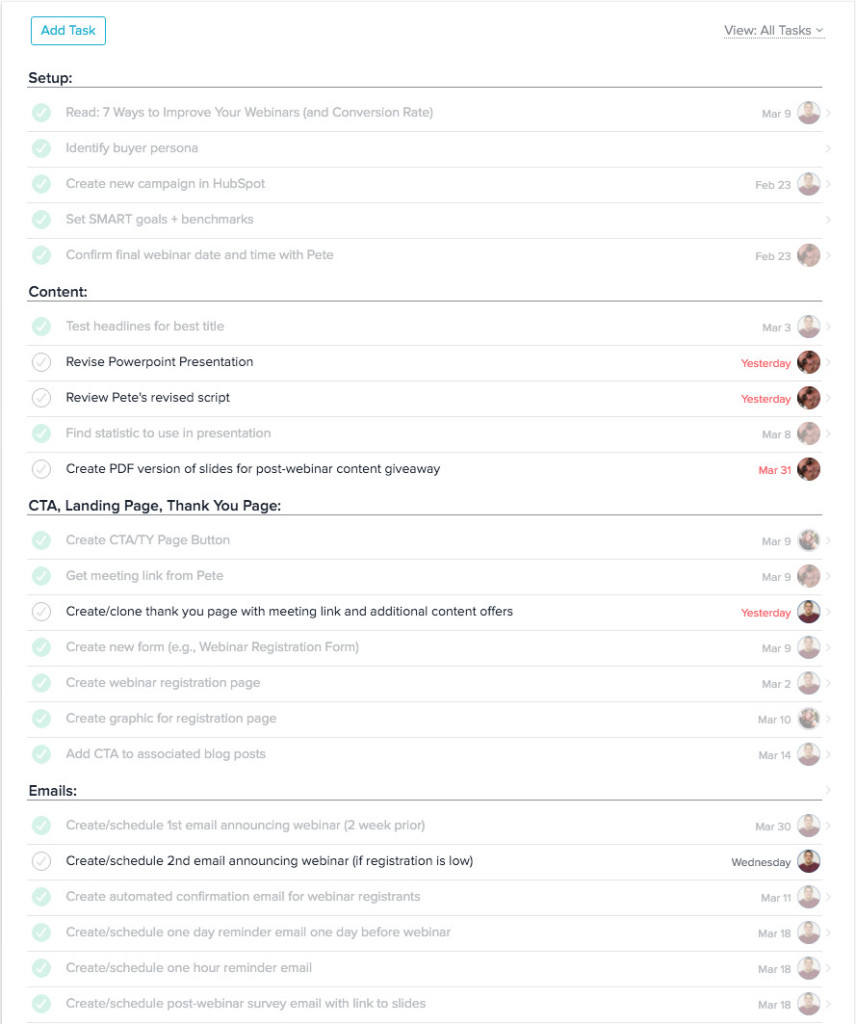
You’ll notice completed Tasks are grayed out. Asana defaults to showing incomplete tasks only. But by changing the view to “All Tasks,” I’m able to see both.
On the right, you can see which team member each Task is assigned to, along with the due date.
You can also view a graph of the Project’s progress and notify your team if it’s off track.
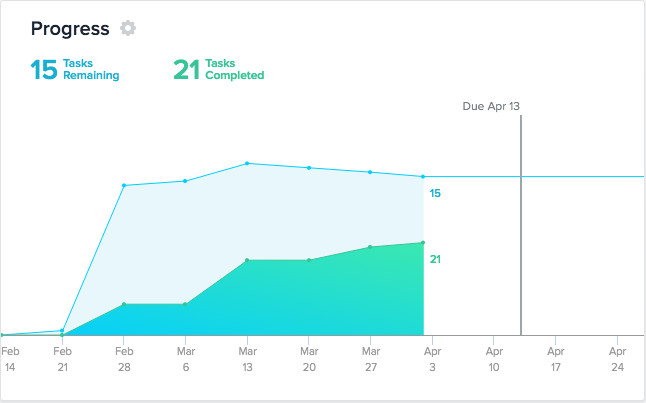
Managing Assets with Asana
Most campaigns require assets like an ebook, CTA button or infographic. Asana integrates with Dropbox, Google Drive and Box, so attaching files from a shared folder in one of these services simplifies asset management.
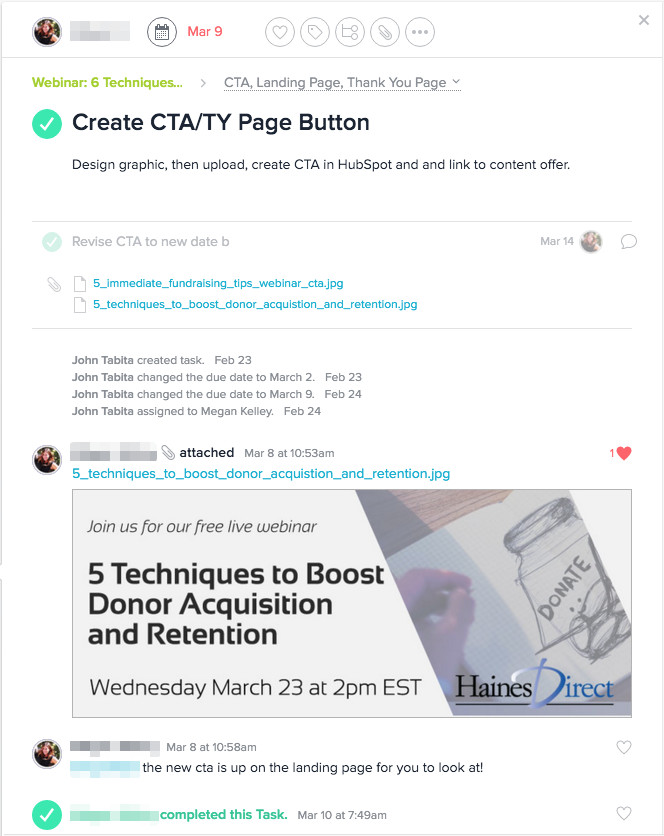
Unlike images, files like PowerPoint or Word don’t display a preview. So unless you keep them in a shared Box, Drive or Dropbox folder, you’ll have to download the attached file to view it.
Using a shared folder has the added advantage of showing the most recent version.
Managing Team Members with Asana
I can view each team member’s Tasks by clicking on their icon:
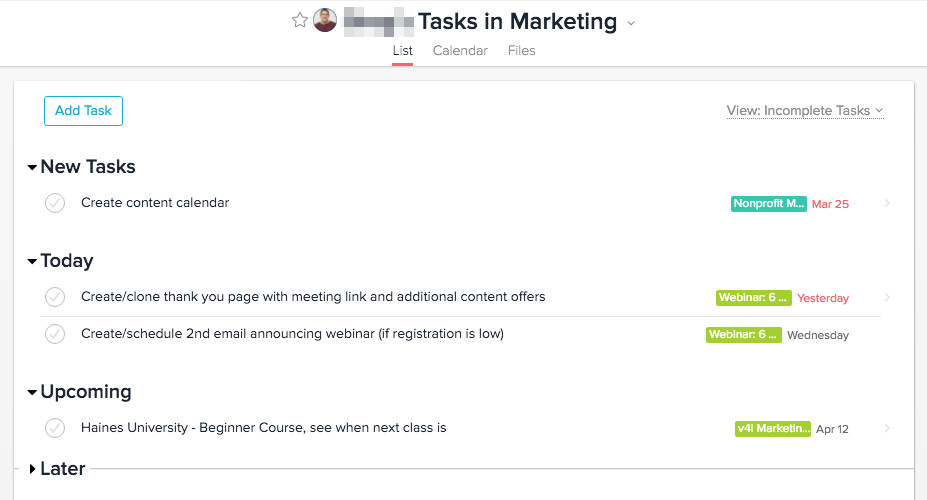
This helps keep our weekly meeting to around 15 minutes, which leads into the next item.
Managing Meetings with Asana
One of Asana’s best features is its ability to associate a Task to more than one Project. This lets me create instant meeting agendas. Here’s how.
Every two weeks, I have a Smarketing meeting with our sales director to collaborate on sales and marketing initiatives. So I created a Project called Smarketing.
Tasks from other Projects that need to be discussed at that meeting are associated with the Smarketing Project:

And I have an instant agenda:

Managing Editorial Content with Asana
Here’s an example of our email marketing schedule, set up as Tasks:

The Task pane allows me to add details like an outline or notes. I can also create Sub Tasks, which I can assign to other team members.
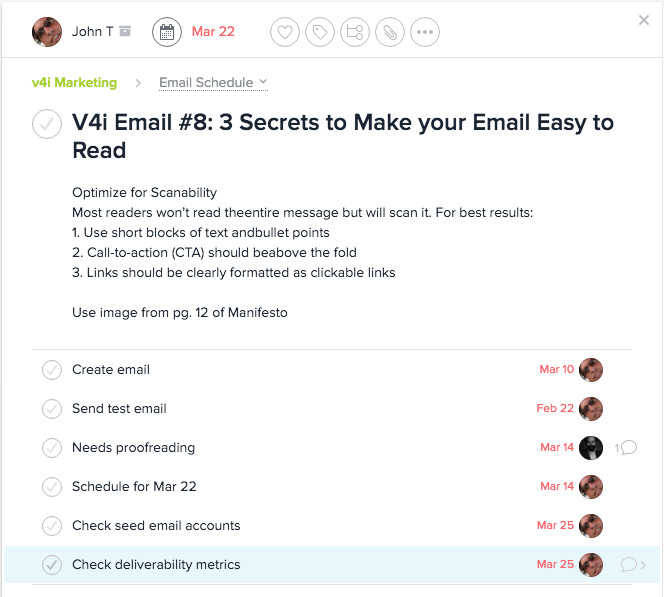
I can view Tasks as a calendar:

Maintaining a Content Library with Asana
Asana is a great place to host an internal library of internal resources or reference materials. For example, I created a Project called “Learning Asana” to help onboard new team members. Under “Do These,” I assign tasks for new members to complete.
The remaining items are reference materials linking to pages on the Asana User Guide.
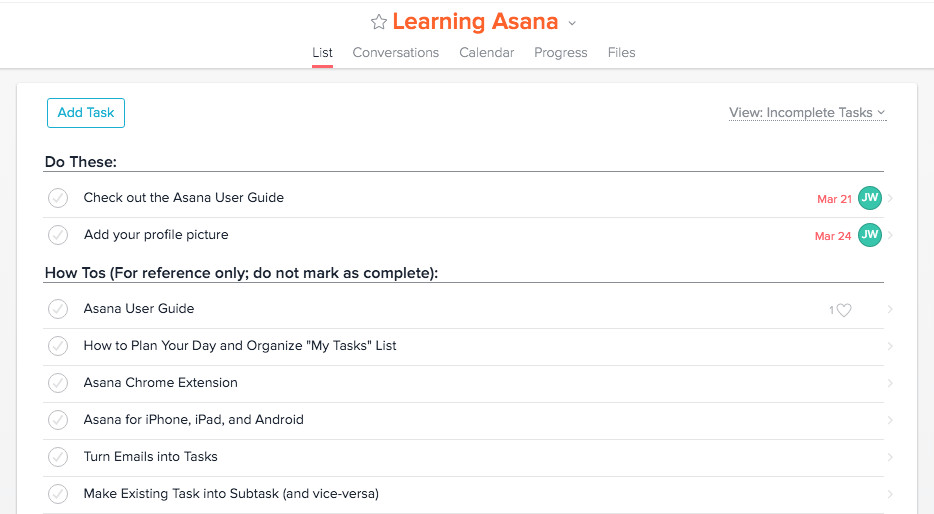
Managing Yourself with Asana
Managing yourself in Asana requires that you monitor My Tasks and My Inbox as closely as you monitor your email inbox.
Using My Tasks
In My Tasks, you’ll see all tasks assigned to you, with new tasks at the top. You can mark these for Today, Upcoming (for another day this week) or Later (for next week or after).
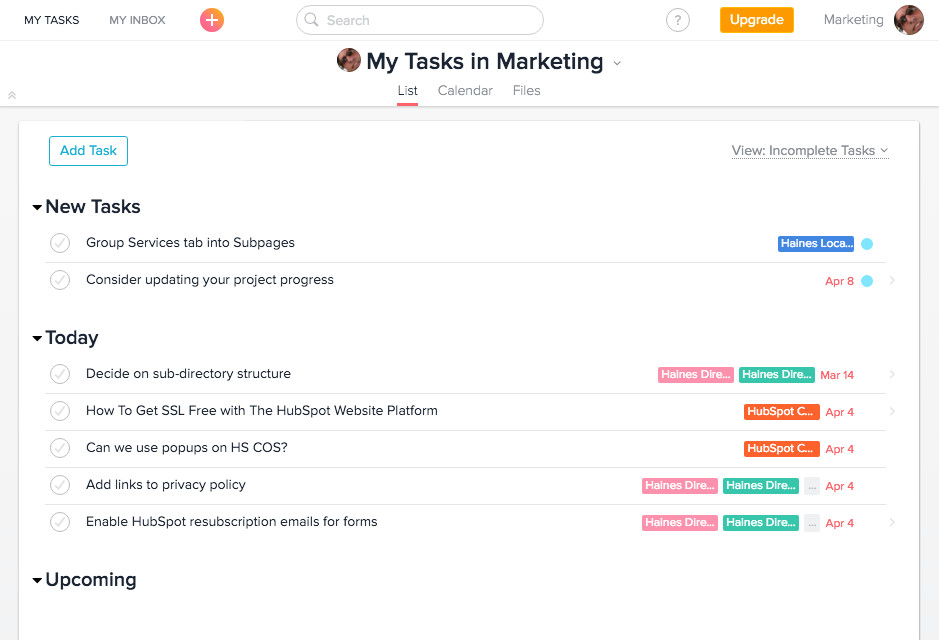
When managing yourself and others, keep these two points in mind:
Don’t Overbook
Try not to schedule more than five tasks a day, unless they’re very minor. Otherwise, My Tasks will look like a 15-car pileup on the 101 freeway, and you’ll spend most of your time revising due dates.
Delegate if Possible
Sometimes I forget I have a team and assign too many tasks to myself, and not enough to others.
Using My Inbox
In My Inbox, you’ll see notifications and comments on all tasks or projects you’re involved in:
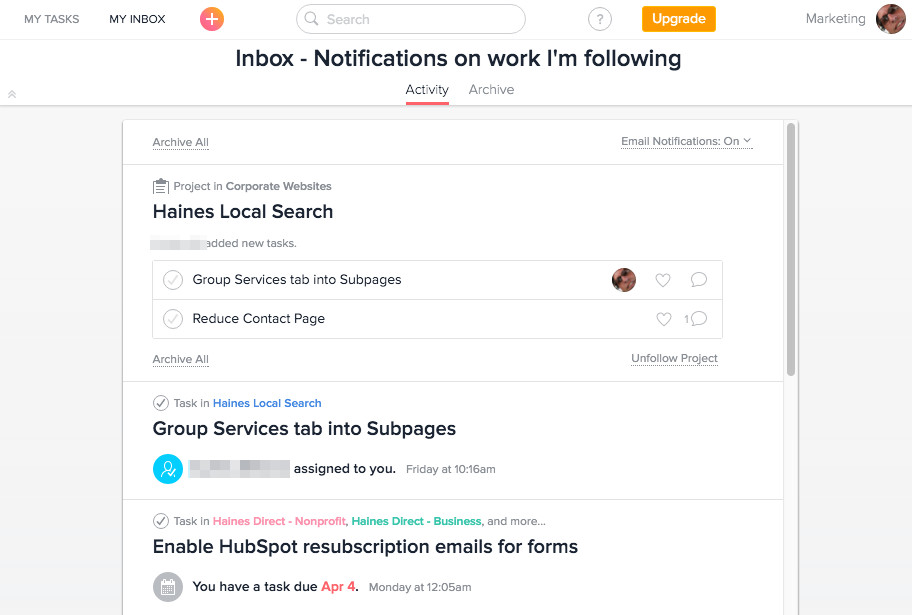
Just like email, you can archive these when you’re done with them.
So What’s the ROI?
By now you’re wondering if Asana’s learning curve is worth the time and effort. I don’t blame you. I’m a firm believer that any activity you commit to should produce a return on investment.
I tend to geek out over productivity hacks, so I probably spent more time in the user guide than most people need to.
But I found that the time and frustration I saved myself was worth the investment. It’s been said that the juice is well worth the squeeze.
That concludes my peek behind the curtain. Now that everyone I collaborate with is using Asana, I spend less time managing my email.
And that’s a beautiful place to be.
Frequently Asked Questions about Managing Projects with Asana
How can I effectively manage my team’s workload using Asana?
Asana provides a feature called Workload that allows you to visualize your team’s capacity and manage their tasks effectively. You can see who is overloaded and who has capacity to take on more tasks. You can also set capacity limits for each team member based on their availability or skill set. This helps in balancing the workload and ensuring that no one is overworked.
Can I integrate Asana with other tools my team uses?
Yes, Asana can be integrated with a wide range of tools such as Slack, Google Drive, Dropbox, and more. This allows you to streamline your workflow and keep all your work in one place. You can attach files from these platforms directly to your Asana tasks, and even turn Slack messages into tasks.
How can I track the progress of my project in Asana?
Asana provides several features for tracking project progress. The Timeline view allows you to see a Gantt chart of your project, showing when each task is scheduled to start and finish. The Progress tab lets you track your project’s progress over time, and you can also set milestones to mark key points in your project.
Can I customize Asana to fit my team’s needs?
Yes, Asana is highly customizable. You can create custom fields to track any information that’s important to your team, such as priority level or cost. You can also customize your project views, create custom templates, and more.
How can I use Asana to improve communication within my team?
Asana can greatly improve team communication by keeping all task-related discussions in one place. Each task has a comments section where team members can discuss the task, ask questions, and provide updates. You can also @mention team members to get their attention, and use the Follow feature to stay updated on tasks that are important to you.
Can I use Asana on mobile devices?
Yes, Asana has a mobile app that’s available for both iOS and Android devices. The app has most of the same features as the web version, so you can manage your tasks and projects on the go.
How can I ensure that my team adopts Asana?
It’s important to provide training and support to your team when introducing a new tool like Asana. You can use Asana’s own resources, such as their Academy and Help Center, to learn about the tool and train your team. It’s also helpful to start small, with a single team or project, and gradually expand as your team becomes more comfortable with the tool.
How can I use Asana to manage multiple projects at once?
Asana’s Portfolio feature allows you to manage multiple projects at once. You can create a portfolio for each team or department, and add all their projects to it. This gives you a high-level view of all the projects, including their status, progress, and deadlines.
Can I use Asana for personal task management?
Yes, Asana is not just for teams – it’s also a powerful tool for personal task management. You can use it to organize your tasks, set deadlines, and even create subtasks for complex tasks.
How secure is my data in Asana?
Asana takes data security very seriously. They use strong encryption to protect your data, both in transit and at rest. They also have strict access controls and regularly undergo security audits to ensure that your data is safe.
Former owner and partner of web firm Jenesis Technologies, John is currently Director of Digital Strategy at Haines Local Search, a company providing local search marketing solutions to SMBs, including print and Internet Yellow Pages, web design, and local SEO. When not working or spending time with his family, John offers great sales and marketing advice on his blog, Small Business Marketing Sucks. When not working or spending time with his family, John offers great sales and marketing advice on his blog, Small Business Marketing Sucks.






